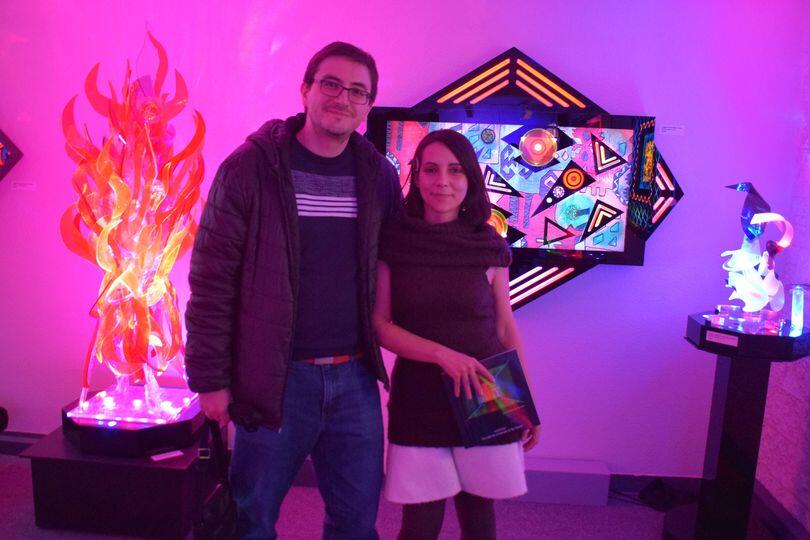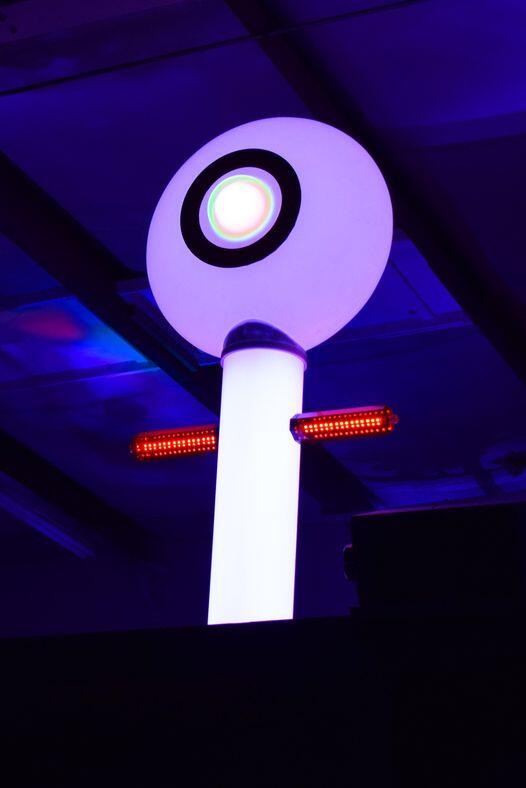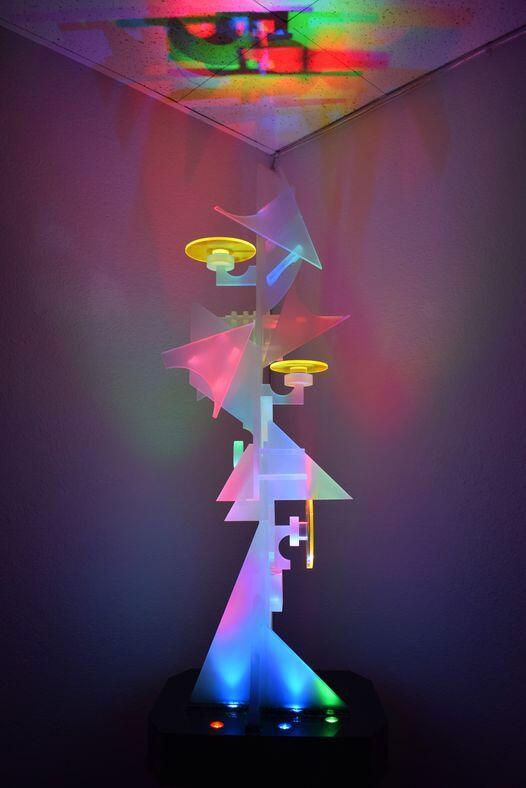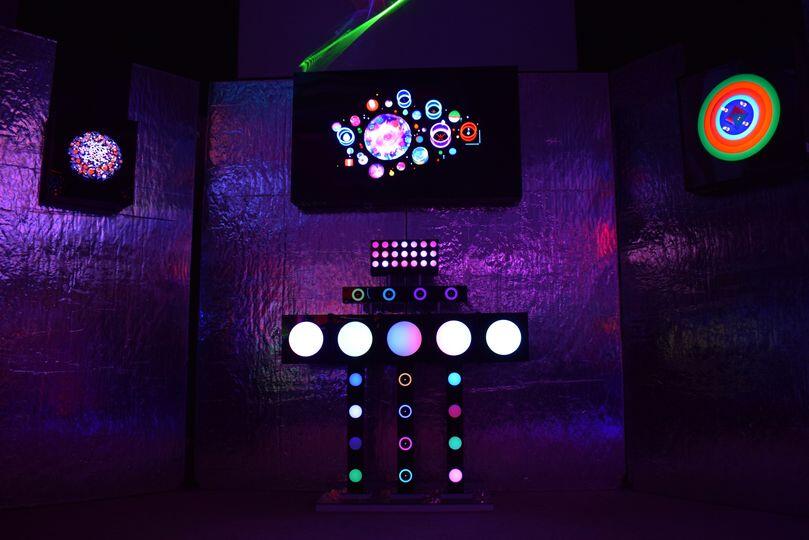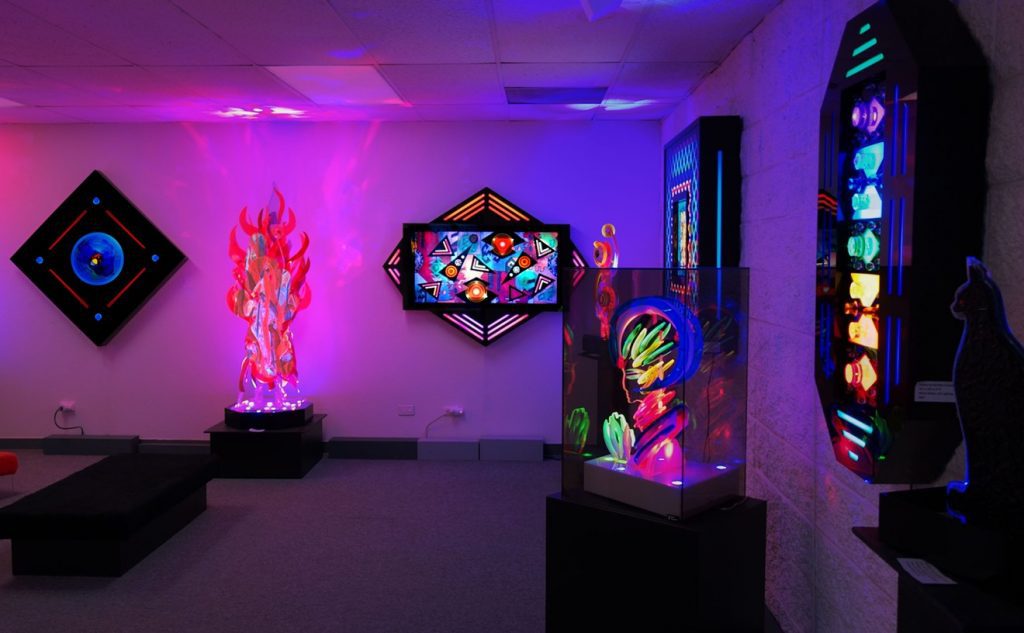Luminous Art Inspiring Our Hearts-n-Minds To Dream With Wonder: Experiencing the Art of Mel and Dorothy Tanner Art
Review by Todd Siler
February, 2017
When I first encountered the art universe of Mel and Dorothy Tanner in the current retrospective exhibition at the Museum of Outdoor Arts, my mind leaped “back to the future”. Sensitively curated by Cynthia Madden Leitner, the selection and assemblage of radiant, mixed media sculptures exude a universal lifeforce, like starlight. They flow with nature’s most brilliant forms of light—including light-emitting diode (LED)s, which were first manufactured in 1962 and discovered artistically by Dorothy Tanner after 1993. In the hands and liberated minds of these two adventurous artists, the medium of light, as embodied and expressed in their sculptural muses, delights more than our eyes alone can absorb.
As this exhibition demonstrates, the creative spirit transcends virtually everything it makes in revealing itself and engaging us with its revelations! That reality becomes even more self-evident when conversing with Dorothy Tanner, the 94 year-old (going on 49) multimedia artist, whose humble wisdom inhabits her most soulful creations.
While gazing at these beautifully crafted and illuminated constructions, I time traveled to the 1970s to 1990s when other innovative artists were exploring new media and aesthetic experiences: sculpting light (James Turrell’s “Danae”; Keith Sonnier’s “Expanded Sel Diptych IV”; Bill Parker’s “Plasma sculptures”); shaping sound (Christopher Janney’s “Physical Music” series, “HeartBeat,” performed by Mikhail Baryshnikov; Paul Earls’ laser drawings and electronic music for operatic productions of “Icarus”); moving us emotionally, conceptually, spiritually with transcendental lightworks (Gyorgy Kepes’s ‘the wizard of light and motion’ ); creating visionary works of environmental art (Otto Piene’s “Light Sculptures” [Weisser Lightgeist] and towering inflatable SkyArt, “Blue Star Linz”); melding symbolic lights in immersive theater using Virtual Reality (Tod Machover’s opera “Valis” based on Philip K. Dick’s novel and performed at MIT’s Media Lab).
Touring the Tanner exhibition at MOA with Barry Raphael was a real treat. This soft-spoken, lifelong friend of Mel and Dorothy helps maintain the archives and manages the Social Media for Lumonics Light & Sound Gallery in Northeast Denver. As Barry highlighted the stories behind the origin and evolution of Dorothy’s luminous lightwork, Floating (1992) and Mel’s glowing plexiglass construction, Transworld (1992), a mosaic of memories swirled around my mind—shaping my responses. I felt myself gazing backwards-and-forwards in seconds, as though I were watching two contrasting scenes in a compelling documentary on artists who were working independently and unaware of one group or another’s endeavors. They were simply parallel playing in the open field of Art & Technology, although many were certainly aware of engineers Billy Klüver and Fred Waldhauer creative collaborations with artists Robert Rauschenberg and Robert Whitman’s “Experiments in Art & Technology (E.A.T.): Projects Outside Art”. These collaborations included 9 Evenings: Theatre and Engineering Event, presented in October 1966 at the 69th Regiment Armory in New York City, Some More Beginning (1968), a groundbreaking international exhibition of art and technology held at the Brooklyn Museum, and the Pepsi Pavilion at Expo 70 in Osaka, Japan. Initially, the 40 engineers and 10 contemporary artists collaborated on art performances using new technology. As Billy Klüver relates in the Archive of published documents: “E.A.T. saw itself as a catalyst for stimulating the involvement of industry and technology with the arts. The organization worked to forge effective collaborations between artists and engineers through industrial cooperation and sponsorship. Membership was opened to all artists and engineers, and an office set up in a loft at 9 East 16th Street in New York”. As synchronicity would have it, three years earlier, Mel and Dorothy Tanner had founded the artists co-op Granite Gallery on 57th Street, New York City. They organized “The New Face in Art” Forum which took place at the Loeb Center at New York University. Participants included Louise Nevelson, Red Grooms, and art writer, Gordon Brown.
Even as my mind embraced these exploratory lightworks, I caught myself reflecting on the short list of artists who were at that time quietly creating cosmic art (Lowry Burgess’s “The Quiet Axis,” which used deep space to stretch our imaginations infinitely and in unprecedented ways); and challenging us to re-think our notions of time, memory and eternity with mind-altering works of art (Arakawa and Madeline Gins’s “Constructing The Perceiver” and “Reversible Destiny”).
Both Arakawa and Burgess aimed to move the arts and world public to new spaces, frontiers and planes of consciousness through their conceptually and physically ethereal artworks: for instance, “The Quiet Axis” was literally lifted into outer space aboard The Space Shuttle, becoming the first nonscientific payload ever. But the unique payload of aesthetics in Burgess’ spaceart possessed a divine spark of inspiration for all-purpose Art: To inspire a world of inquisitive minds to consider how the entire cosmos will remain a real canvas of sorts—and not just a virtual or cybercanvas—in which we can all create or discover new meanings and purposes for artful human ingenuity.
One common thread linking this spectrum of artistic endeavors was none other than Nature’s magnificent “light”—experienced in all its tangible, conceptual and metaphorical manifestations. Dorothy Tanner infuses her lively light art with natural and synthetic sounds, video and film projections, and interactive art performances—many of which resonate with the freewheeling spirit of Alan Kaprow’s “Happenings”. In any event, that’s one special addition and contribution of her exploratory work, much of it propelled by play and raw curiosity, shaping Contemporary Art.
Collectively, these artists transformed our natural and built environments into unforgettable worlds of fresh thoughts fueled by their creative inquiries and our’s in response to their work. They continue to challenge and change our perceptions of physical reality in spanking new, often theatrical, ways. Their experimental works open the aperture of our mind’s eyes to catch glimpses of that elusive “Reality Distortion Field” that many pioneering artists today invoke as they aspire to ‘put a dent in the universe’—as Steve Jobs once proclaimed in his grand pursuit of advancing our personal computing devices. In a very real sense, I experienced another kind of reality distortion field walking into Dorothy Tanner’s cocoon-like world of Lumonics, where this artist has used various light sources to create powerful aesthetic experiences that reverberate throughout your body-mind-spirit in richly subtle ways.
I can’t explain why I had this enlightening experience while absorbing the light of these two cosmic works of art, “Blue Burst” and “Gleaming,” that glow like neighboring stellar bodies among a constellation of brainstars lighting up the darkest spaces of Lumonics. But I did. And that experience feels indelible.
Uninfluenced by any substance or drugs, I felt the presence of some spiritual thoughts manifested in these ethereal constructions that evoked images of forces of nature. My fifth impression left me wondering how this expressive art can draw us so into that one infinitely mysterious space of above All: Our deepest feelings of being personally connected with everything Nature is and may be with imagination.
I never asked Dorothy if either she or her beloved life partner and art collaborator, Mel (1925-1993), were familiar with the works of the 17th century Rationalist philosopher, Barauch Spinoza. (I figured Dorothy must have, because she shared with me how she loved reading great literature; it remains her wellspring of inspiration for her art, along with music.) No doubt, the light of their radiant art would surely have touched Spinoza’s life whose insights into Ethics continue to influence our contemporary lives.
What I experienced while momentarily embracing their art, was a connection with “the devine” sparks of creativity in human/nature alike. I very rarely use or refer to that vaporous term, because, I’m not religious whatsoever (even though I’m Jewish and spiritual through-in-through). And I don’t see Nature as some manifestation of “Intelligent Design”. However, I do believe in intelligent, inquisitive people who, by nature, are forever humbled by our human ingenuity, ‘inventional wisdom’ and the power of our “collaborative creative genius”. After all, that force enables us to do impossible things— including survive our most stupid human catastrophes.
Those thoughts flowed from my viewing up-close-and-personal Tanner’s art. In hindsight, I couldn’t imagine not connecting their art with something as powerful as Spinoza’s notion of [one] God, which ‘from which an infinite number of things follow in infinite ways.’ “By God, I mean a substance consisting in infinite attributes,’ writes Spinoza, “of which each expresses eternal and infinite essentiality.”
Keep in mind that Spinoza famously said, “Nature abhors a vacuum.” Well, the art of Mel and Dorothy Tanner appears to abhor a vacuum, too!
“Proprioceptive thinking” may be a term some cognitive neuroscientists and casual art observers alike might associate with this art. But that label and line of thinking would still miss the mark of this art’s beautiful essence. Hidden in the layers of structured colors are Dorothy’s metaphorical expressions of light and life. They draw your eyes to them like watching iridescent butterflies landing-on-and-leaving vibrant flowers in a Brazillian rainforest! The net effect of these sculptures: delight and challenge. Implying, they delightfully challenge our imagination to experience these radiant works of visceral art as pure forms of energy without any boundaries to their mass and meanings.
Essentially, these illuminated sculptures make good on her use of light to ‘create, define, and solidify’ matter (quoting Tanner); and, to ‘leave in shadow that which we believe is real.’
How’s that possible? By controlling the quality and intensity of light, which are core to her sculptural muses. That control marks her mastery of this art.
Lumonics is currently applying these aesthetics in an art installation at The Scarlet in Central City, a former casino on Main Street that’s being transformed into a mental health treatment and wellness center of sorts. The Scarlet will serve the needs of individuals seeking relaxation and meditation. It will provide stress-reducing environments and healing experiences augmented by Tanner’s light sculptures and video projections. This Lumonics Mind Spa was conceived as part of the 7 Stars Oneness Center that Jomar Suarez, MD founded some years ago. Dr. Suarez, who’s a certified practicing psychiatrist, plans to apply the therapeutic aspects of Dorothy Tanner’s multisensory art with lights, sounds and videoworks for treating post-traumatic stress disorder (PTSD), starting with our war veterans. This program is being collaboratively developed with Dorothy’s longtime associates Marc Billard, Barbara Ungar and Barry Raphael.
“Burning Bush” and “Cool Cat”—two works that cohabit her spacious studio —exemplify how art can be “relatable to human form from the start…” as Dorothy noted. “These artworks evolved from abstract images to representational images, and the reverse.” There’s no set path to their sudden or deliberate evolution.
Allowing the artwork to show-and-tell you what it wants to be is “being open to the present,” Dorothy expressed, in conveying her experiences and what she self-learned from grasping her earliest artworks.
We both learned that day: “Being present” in your art makes your art a present for any inquisitive viewer to open and enjoy.
In our impromptu interview, Dorothy said almost whispering: “I come to it [Art] as innocent…” a fact concurred by Marc Billard, Dorothy and Mel’s art collaborator of some fifty years. According to Dorothy, Marc made it possible to make these elegant structures using new tools and materials and novel approaches to transforming the images through lights, sounds, textures, and other medium that enrich our lives immeasurably.
Leaving Lumonics that day, I realized this tribe of exceptionally gifted artists are, indeed, ‘reinventing the image with light’, to quote a caption in the MOA signage. And they’re doing so in their individual ways of innovating.
I suppose “beautiful souls” like “beautiful minds” naturally create artworks that resonate with our inner world and sense of “being.” Like the sensual forces of radiant light and melodious sounds, they stimulate our whole nervous system and not simply a portion of our cerebral cortex that specializes in understanding our sensory impressions and life experiences.
(1)What would you like the whole world to know about your art? Why? (
2) What do you hope to accomplish through your art? Why and how is it possible?
(3) What matters most to you about people experiencing your art? What do you want their “Takeaway” to be in reality, action and memory?
(4) What do you feel is most memorable and significant about your art beyond the History of Art?
(5) Do you start with a concept that conveys what you care to communicate? Or do you simply create aesthetic experiences that treat your imagination—and ours—to the delights of curiosity, wonder and possibility?
Without preparing their minds to respond, I add these two inspirational observations offered by two outstanding innovators in the Arts & Sciences: Joseph Beuys, multimedia artist and Albert Einstein, visionary physicist. In 1978, Beuys famously declared: “Everyone is an artist!” It was as bold and emphatic a declaration as Einstein’s statement: “Everyone is born a genius.” Which he elaborated on, to be clear. “But if you judge a fish by it’s ability to climb a tree, it would go through its whole life believing it was stupid.”
R. Buckminster Fuller, one of the most renowned polymaths and art humanists of the 20th century, held a similar views on our innate genius. Bucky claimed, “We are all geniuses. But we spend our formative years degeniusizng ourselves!” How? By insisting that there’s only one right way to think, create, learn, and perform—rather than maintaining a more open minded, pluralistic view.
And both Einstein and Fuller were certainly not alone in their perspectives and observations on genius. From my evidence-based perspective and research on Creativity, I‘ve come to conclude: Genius is everywhere, everyday, in everyone, in every way imaginable. Genius is in our genes. It’s what our genes do for a living, literally and figuratively speaking.
In fact, it’s one of the most inspirational realities any human being can experience the moment we open our ‘One Good Eye’ (to borrow journalist Ray Mark Rinaldi’s wise expression)—and use our open-mind to see one of the most beautiful things about Art: It is not only what we make, it’s also what we make of it! We make much more of it by relating it to our personal lives and experiences, the deeper and richer the experience of it.
Art that actually cultivates these broader and deeper aesthetic experiences tend to become “unforgettable”: meaning, they’re personally meaningful, relevant, memorable, and useful. In countless ways.
Dorothy’s all hands-on, as a lifelong learner touching-and-feeling her way to understand things. She learns by experimenting: manipulating clay, sculpting sounds in her mind’s eyes, and drawing inspiration from the primordial beats of contemporary life. Absorbed in her dreamy intuitions, she moves from concept to its visualizations and back to concept—again and again—only stopping periodically to smoke a cigarette or a joint.
When I asked Dorothy to describe one of her earliest memories that lead her to make art, she instantly replied: “One event that shocked and shaped my life as a little girl, I can remember my elementary school teacher asking our class to draw pictures of “Cowboys and Indians” and I just couldn’t bring myself to do it—not to his satisfaction. He humiliated me so badly in front of the class I was scared to make art….”
Dorothy paused to reflect and wonder. “It took many years to slowly change this 6 year-old’s impression… Eventually, when I was about 15 years-old, I tried my hand at using clay to express myself. That medium, along with music and dance, enabled me to start discovering myself….I discovered I love to dance and listen to all kinds of music…” Little wonder, music is in her background. “My two brothers, whom I adore, were absorbed by music: one obsessed over opera and the other over jazz….But it was the World of Light and Sounds and Literature that really drew me deep into Art. The Russian novelist Dostoyesky and playwright Chekhov” were among her favorites. And, I gather, Mel Tanner’s too, as his family were from Kieve, Ukraine.
Looking around her dark, yet radiantly colorful, studio, we see the presence of glowing lights and sounds that seamlessly meld into one atmosphere of peaceful, vibrant energy streaming from these radiant works of visceral art.
“I fell in love with music and literature, before I moved into the visual arts by late adolescence…before I became fluent in the language of clay, which I just eased into as I kneaded it.”
Tell me more, I inquired. “What’s your very earliest memory?” And Dorothy quickly recalled creating the most emotionally powerful mask she ever made. “It was a portrait of a Holocaust child,” she related. “Everything I made, from that point on, was all about art moving our emotions from one state of mind and experience to another….That’s what was most important to me.”
From that defining moment forward, her ideas moved fluidly from realism to abstraction back-and-forth endlessly. One could become the other: a representational image of a cat could morph into an abstract form with catlike qualities, as long as her imagination was free from the ‘tyranny of logic.’
Many human beings are “Called to Art”, not unlike natural born soldiers who feel the Call of Duty: The Ultimate Sacrifice—and not merely as something to do to do something. But called as if by some internal necessity—some inner force—to be and to do something that’s completely true to their creative spirit. Implying, they feel compelled to be true to everything they are and not just fantasize about being. It’s a real “calling.” Actually, it’s Life Calling, as I know it profoundly. It’s that howl in the Wilderness of Creativity to make Great Art or die trying.
Many of Dorothy and Mel’s art forms seem come from that inner calling, insisting: There’s nothing else you can do better with your life that would enable you to remain true to yourself.
Both individuals felt pulled to playfully experiment with every medium and material they could get their hands on—plying it purposefully to experience the possibilities they were envisioning for it. Of course, many experiments failed: they didn’t yield some desired aesthetic experience that delighted their six senses—including intuition.
That’s what “aesthetic success” meant to them emotionally. A successful work of art embodies that fundamental joy; that feeling the artwork conveys one’s “essence” and way of being! That is, being true to oneself.
Through art. I can hear Miles Davis saying: “It takes long time to be able to play like yourself”. That is, to courageously play! To play like no other musician in the world but yourself. “Be wrong, strong!” Davis said defiantly.
I’d add: Never mind being wrong, live your wisdom which is always doing the right thing for you!


